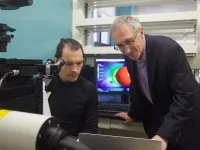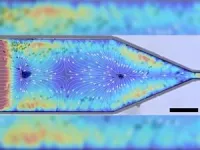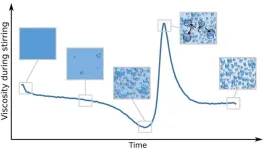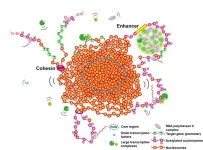(Press-News.org) UNIVERSITY PARK, Pa. — Acoustic waves may be able to control how particles sort themselves. While researchers have been able to separate particles based on their shape — for example, bacteria from other cells — for years, the ability to control their movement has remained a largely unsolved problem, until now. Using ultrasound technology and a nozzle, Penn State researchers have separated, controlled and ejected different particles based on their shape and various properties.
They published their results in the journal Small.
“We engineered a microchannel nozzle and applied ultrasound energy to the system,” said corresponding author Igor Aronson, the Penn State Dorothy Foehr Huck and J. Lloyd Huck Chair Professor of Biomedical Engineering and professor of chemistry and of mathematics. “The nozzle plays two roles. It concentrates fluid flow, which is something other researchers have done. But in addition to that, the walls of the nozzle reflect the acoustic waves of the ultrasound energy.”
Aronson and his collaborators worked with tiny materials called nanorods, which are some of the most studied synthetic self-propelled particles, according to Aronson. Because they are a similar size and have a similar swimming speed to bacteria, Aronson said, many of the conclusions drawn from observing nanorods can be applied to bacteria movement. For this reason, they are often used as proof of concept for future separation tasks.
In this case, the nanorods were half platinum and half gold. The researchers placed the nanorods in a nozzle, shaped like a miniature syringe, and then added hydrogen peroxide. The hydrogen peroxide is decomposed — or burned — on the platinum half of each nanorod, forcing them to swim in an imitation of how bacteria behave.
The researchers applied ultrasound to the nozzle, producing acoustic waves that, along with the flow of fluid, were able to separate the nanorod particles, aggregate them or extrude them from the nozzle.
"The separation concept relies on the fact that nanorods and spherical particles have different responses to acoustic radiation and generated fluid flow,” Aronson said. “By controlling the nozzle shape and the frequency and amplitude of the acoustic radiation, we can coerce particles of different shapes and material properties to behave differently. This, especially, applies to active particles such as nanorods: They can swim autonomously, and their control is especially challenging.”
This level of control in separating out particles had not been demonstrated previously, according to the researchers.
Aronson said this demonstration has implications for future technologies, including additive manufacturing, also known as 3D printing, and drug delivery.
“For 3D printing, the idea is you can add certain additives to the ink — for example, nanorods,” he said. “So now, we could separate nanorods from spherical particles to deposit only some in the printout, such as depositing polymers without nanorods and so on, all to change the property of the printout.”
Aronson said this principle also applies to printing living cells, known as bioprinting.
“Potential bioprinting applications may include designing acoustic nozzles for bio-inkjet-like printers,” he said. “By controlling the acoustic radiation in the nozzle, we can potentially extrude certain types of cells — for example, stem cells — and trap other types — for example, bacteria. It’s an additional control for bioprints.”
This capability could also be useful for separating bacteria from cells in targeted drug delivery, Aronson said. The researchers next plan to mix live bacteria and cells in a lab setting and then separate and control them.
The paper’s other authors are Leonardo Dominguez Rubio, a graduate student in the Penn State Department of Biomedical Engineering; Ayusman Sen, the Verne M. Willaman Professor of Chemistry at Penn State; and Matthew Collins, who was a Penn State chemistry graduate student at the time of this work.
The U.S. Department of Energy supported this work.
END
Penn State researchers use ultrasound to control orientation of small particles
The demonstration has implications for drug delivery and bioprinting, according to scientists
2023-06-27
ELSE PRESS RELEASES FROM THIS DATE:
Fondant: Where baking and thermodynamics mix
2023-06-27
WASHINGTON, June 27, 2023 – With their unique appearance, texture, and mouthfeel, fondants have intrigued bakers and physicists for years. They present an appetizing enigma in the world of confectionery, an intriguing combination of sugar, water, and heat that, when manipulated correctly, yields a delectably creamy product.
Researchers from the Max Planck Institute for Polymer Research and Technische Universität Berlin studied the kinetic and thermodynamic processes of sugar crystallization in the making of fondant. In Physics of Fluids, by AIP Publishing, they combined a controlled kneading machine with light microscopy ...
Prevalence of iron deficiency, iron-deficiency anemia in females ages 12-21
2023-06-27
About The Study: Among 12- to 21-year-old U.S. females between 2003 and 2020, iron deficiency affected almost 40% and iron deficiency anemia affected 6%, with variation by the ferritin or hemoglobin thresholds used. Menstruation was a risk factor for both, but more than one-quarter of premenarchal individuals had iron deficiency.
Authors: Angela C. Weyand, M.D., of the University of Michigan Medical School in Ann Arbor, is the corresponding author.
To access the embargoed study: Visit our For The Media website at this link https://media.jamanetwork.com/
(doi:10.1001/jama.2023.8020)
Editor’s Note: Please see the article for ...
Team proposes a new view on euchromatin in the cell
2023-06-27
In their paper the team discusses their novel view of euchromatin in the cell and shows how the revealed organization is relevant to genome functions. “Our ultimate goal is to reveal how genomic information is searched and read out in living cells,” said Kazuhiro Maeshima, a leading author and a professor with the National Institute of Genetics and SOKENDAI, Japan.
Chromatin describes the combination of DNA and proteins in the cells of humans and other eukaryotes. According to typical textbook models, chromatin occurs in two forms— euchromatin, that is less condensed and can be transcribed, and heterochromatin, that is more condensed and usually not transcribed. ...
Monitoring British bats can help identify coronaviruses with pathogen potential
2023-06-27
Researchers who found novel coronaviruses in UK bats say genetic surveys of the viruses should be regularly conducted, even if none of those viruses can infect humans yet.
Working with a network of bat conservationists, a research team led by Imperial College London and University College London researchers screened faecal samples from UK bats for coronaviruses.
Their results, published today in Nature Communications, report circulation of four species of coronaviruses, including two novel ones, among the 16 UK bat species sampled. While some of these ...
Chemical imbalance in the forebrain discovered in people with obsessive-compulsive disorder
2023-06-27
Using a high-powered MRI scanner, scientists have discovered an imbalance between neurochemicals in parts of OCD patients’ brains key to decision-making and habit.
Chemical imbalances were related to OCD symptom severity, as well as habitual tendencies in a decision-making task.
A similar but less pronounced neurochemical imbalance was also detected in healthy individuals with milder compulsive tendencies.
Neuroscientists argue that the findings are a “major piece of the puzzle” in understanding OCD, and could open up new ...
Researchers develop new base editing tools using AI-predicted protein structure clustering
2023-06-27
GAO Caixia's group from the Institute of Genetics and Developmental Biology of the Chinese Academy of Sciences has pioneered the use of artificial intelligence (AI)-assisted methods to discover novel deaminase proteins with unique functions through structural prediction and classification.
This approach has opened up a range of applications for the discovery and creation of desired plant genetic traits.
The results were published in Cell.
The discovery of new proteins and the exploitation of diverse engineered enzymes have contributed to the rapid advancement of biotechnology. Currently, efforts to mine novel proteins ...
New study sheds light on the evolution of animals
2023-06-27
Key points:
Scientists have been mystified as to why animals are missing in much of the fossil record;
Researchers have developed a new method to determine if animals really were absent during certain geological eras, or if they were present but too fragile to be preserved;
The findings establish a new maximum point at which animals first evolved on Earth.
A study led by the University of Oxford has brought us one step closer to solving a mystery that has puzzled naturalists since Charles Darwin: when did animals first appear in the history of Earth? The results have been published ...
Associations between socioeconomic status, obesity, cognition, and white matter microstructure in children
2023-06-27
About The Study: Neighborhood and household contexts were associated with white matter development in children, and findings suggested that obesity and cognitive performance were possible mediators in these associations. Future research on children’s brain health may benefit from considering these factors from multiple socioeconomic perspectives.
Authors: Scott Marek, Ph.D., and Tamara Hershey, Ph.D., of the Washington University in St. Louis School of Medicine, are the corresponding authors.
To access the embargoed study: Visit our For ...
Humans' ancestors survived the asteroid impact that killed the dinosaurs
2023-06-27
A Cretaceous origin for placental mammals, the group that includes humans, dogs and bats, has been revealed by in-depth analysis of the fossil record, showing they co-existed with dinosaurs for a short time before the dinosaurs went extinct.
The catastrophic destruction triggered by the asteroid hitting the Earth resulted in the death of all non-avian dinosaurs in an event termed the Cretaceous-Paleogene (K-Pg) mass extinction. Debate has long raged among researchers over whether placental mammals were present alongside the dinosaurs before the mass extinction, ...
Poverty negatively impacts structural wiring in children’s brains, study indicates
2023-06-27
A new study from Washington University School of Medicine in St. Louis suggests that growing up in poverty may influence the wiring of a child’s brain.
The study, published June 27 in JAMA Network Open, indicates a link between both neighborhood and household poverty and the brain’s white matter tracts, which allow for communication between brain regions. White matter plays a critical role in helping the brain process information.
The findings stem from the largest long-term study of brain development and child health conducted in the U.S. — ...
LAST 30 PRESS RELEASES:
Mental trauma succeeds 1 in 7 dog related injuries, claims data suggest
Breastfeeding may lower mums’ later life depression/anxiety risks for up to 10 years after pregnancy
Study finds more than a quarter of adults worldwide could benefit from GLP-1 medications for weight loss
Hobbies don’t just improve personal lives, they can boost workplace creativity too
Study shows federal safety metric inappropriately penalizes hospitals for lifesaving stroke procedures
Improving sleep isn’t enough: researchers highlight daytime function as key to assessing insomnia treatments
Rice Brain Institute awards first seed grants to jump-start collaborative brain health research
Personalizing cancer treatments significantly improve outcome success
UW researchers analyzed which anthologized writers and books get checked out the most from Seattle Public Library
Study finds food waste compost less effective than potting mix alone
UCLA receives $7.3 million for wide-ranging cannabis research
Why this little-known birth control option deserves more attention
Johns Hopkins-led team creates first map of nerve circuitry in bone, identifies key signals for bone repair
UC Irvine astronomers spot largest known stream of super-heated gas in the universe
Research shows how immune system reacts to pig kidney transplants in living patients
Dark stars could help solve three pressing puzzles of the high-redshift universe
Manganese gets its moment as a potential fuel cell catalyst
“Gifted word learner” dogs can pick up new words by overhearing their owners’ talk
More data, more sharing can help avoid misinterpreting “smoking gun” signals in topological physics
An illegal fentanyl supply shock may have contributed to a dramatic decline in deaths
Some dogs can learn new words by eavesdropping on their owners
Scientists trace facial gestures back to their source. before a smile appears, the brain has already decided
Is “Smoking Gun” evidence enough to prove scientific discovery?
Scientists find microbes enhance the benefits of trees by removing greenhouse gases
KAIST-Yonsei team identifies origin cells for malignant brain tumor common in young adults
Team discovers unexpected oscillation states in magnetic vortices
How the brain creates facial expressions
Researchers observe gas outflow driven by a jet from an active galactic nucleus
Pitt student finds familiar structure just 2 billion years after the Big Bang
Evidence of cross-regional marine plastic pollution in green sea turtles
[Press-News.org] Penn State researchers use ultrasound to control orientation of small particlesThe demonstration has implications for drug delivery and bioprinting, according to scientists





